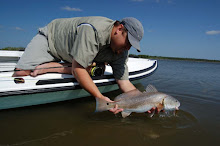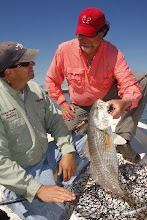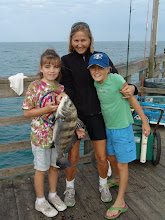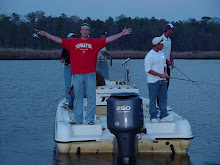
Once again our NC Marine resources suffer at the hands of our commercially run Marine Fisheries Commission. Under the guise of caring about wasted fish, the commission voted to "not comply" with the Atlantic States Fisheries Commission and reduce commercial harvest of Gray Trout to 100 pounds per day per vessel, and one fish per day for recreational fishermen.
The ASMFC could request the US Secretary of Commerce to step in and shut the Gray Trout fishery in NC completely down!
This is exactly what needs to happen to protect this beautiful sportfish! From 1978 to 1990, the commercial fishing fleet here in NC sold over 160 Million pounds of Gray Trout at an average of 32 cents per pound! Now, with no limits whatsoever, they have only harvested less than 200 thousand pounds in the last few years.
Fisheries biologist say the Gray Trout stocks are at an all time low, and what do our NC commercial fishermen want to do? They demand that they be allowed to go catch what is left of them! Even when all the states on the Atlantic Coast voted to do otherwise!
Not only can they make such horrific demands, since they are the "foxes guarding the hen house," they can make their own rules to play by and do as they wish with our fisheries!
This egregious display of blatant disregard for our marine resources gives not only North Carolinians reason for pause, but for our neighboring states on the Atlantic Coast as well.
If there were ever any doubts about the true nature and intent of our Marine Fisheries Commission, they have now all been erased!
It is high time that the current system of marine resource management be overturned and overhauled! Maybe the Feds will step in and help us get it done!
The CFRG sent the following email to every member of the ASMFC on March 26, 2010....
Dear ASMFC Member,
Once again, North Carolina’s Marine Fisheries Commission puts money and profit at a higher priority than the health of a depleted Weakfish fishery. In spite of the intense studies and debate that the ASMFC has engaged in on behalf of Weakfish, NC MFC has decided that they know better and will just thumb their noses at sound, biological fisheries management.
Is it any wonder? Does this really surprise any of you who understand that North Carolina Marine Fisheries are run by commercial fishermen that only understand the price of a fish sold, and not the value of a fish preserved? Many of us here in NC are growing weary of the constant battle to achieve sound fisheries management, and now we must turn to you for help!
Will you help us? Will you do what is right for the Weakfish before it is too late?
Please use the power that is given to you and demand that NC adhere to the Weakfish regulations that the ASMFC supports. If they refuse, please request that The Secretary of Commerce SHUT DOWN completely the NC Commercial and recreational Weakfish fishery until the stocks recover.
Concerned North Carolinians need you to step up and do the right thing, in light of the shameful actions of a politically run NC Marine Fisheries Commission!
Please let us know your feelings on this subject, and thank you for your service on behalf of our Atlantic States Fisheries!
The ASMFC could request the US Secretary of Commerce to step in and shut the Gray Trout fishery in NC completely down!
This is exactly what needs to happen to protect this beautiful sportfish! From 1978 to 1990, the commercial fishing fleet here in NC sold over 160 Million pounds of Gray Trout at an average of 32 cents per pound! Now, with no limits whatsoever, they have only harvested less than 200 thousand pounds in the last few years.
Fisheries biologist say the Gray Trout stocks are at an all time low, and what do our NC commercial fishermen want to do? They demand that they be allowed to go catch what is left of them! Even when all the states on the Atlantic Coast voted to do otherwise!
Not only can they make such horrific demands, since they are the "foxes guarding the hen house," they can make their own rules to play by and do as they wish with our fisheries!
This egregious display of blatant disregard for our marine resources gives not only North Carolinians reason for pause, but for our neighboring states on the Atlantic Coast as well.
If there were ever any doubts about the true nature and intent of our Marine Fisheries Commission, they have now all been erased!
It is high time that the current system of marine resource management be overturned and overhauled! Maybe the Feds will step in and help us get it done!
The CFRG sent the following email to every member of the ASMFC on March 26, 2010....
Dear ASMFC Member,
Once again, North Carolina’s Marine Fisheries Commission puts money and profit at a higher priority than the health of a depleted Weakfish fishery. In spite of the intense studies and debate that the ASMFC has engaged in on behalf of Weakfish, NC MFC has decided that they know better and will just thumb their noses at sound, biological fisheries management.
Is it any wonder? Does this really surprise any of you who understand that North Carolina Marine Fisheries are run by commercial fishermen that only understand the price of a fish sold, and not the value of a fish preserved? Many of us here in NC are growing weary of the constant battle to achieve sound fisheries management, and now we must turn to you for help!
Will you help us? Will you do what is right for the Weakfish before it is too late?
Please use the power that is given to you and demand that NC adhere to the Weakfish regulations that the ASMFC supports. If they refuse, please request that The Secretary of Commerce SHUT DOWN completely the NC Commercial and recreational Weakfish fishery until the stocks recover.
Concerned North Carolinians need you to step up and do the right thing, in light of the shameful actions of a politically run NC Marine Fisheries Commission!
Please let us know your feelings on this subject, and thank you for your service on behalf of our Atlantic States Fisheries!










.jpg)






